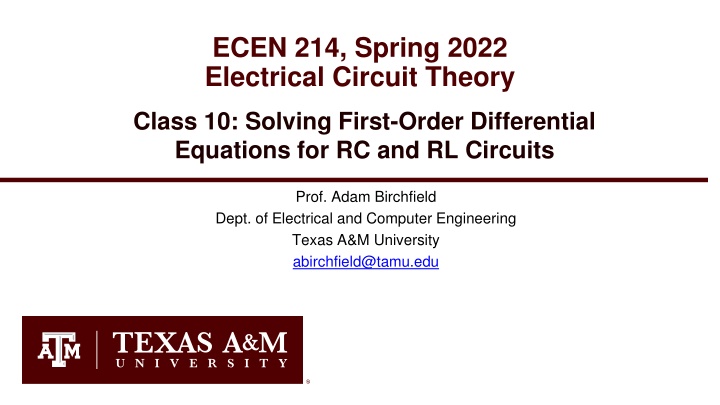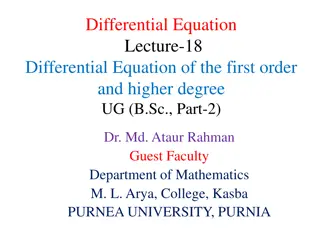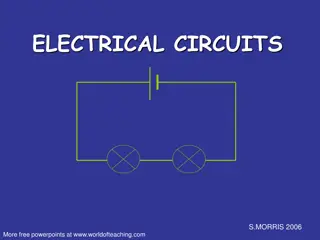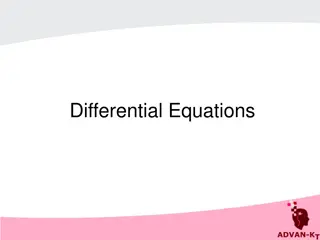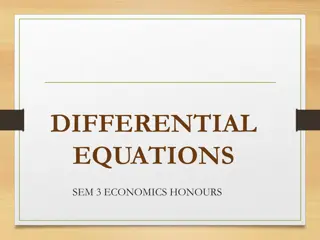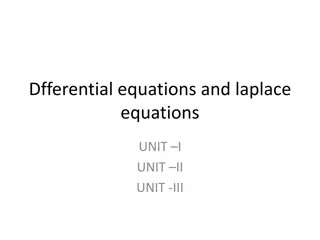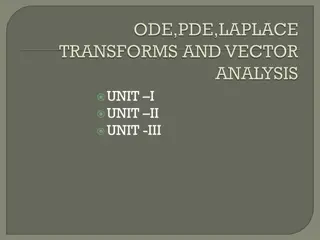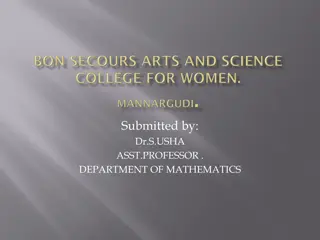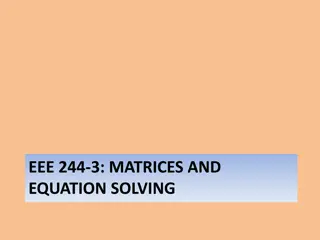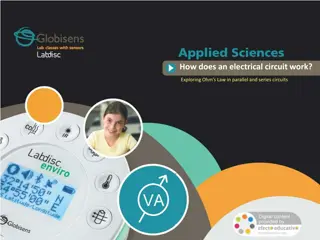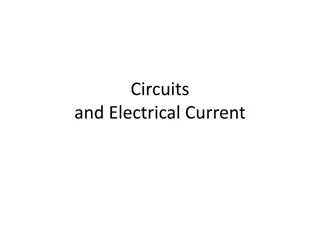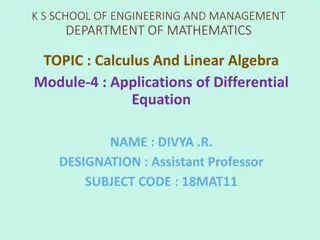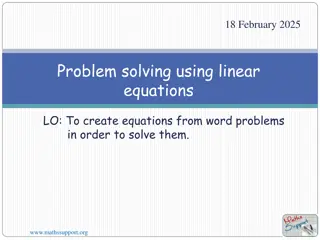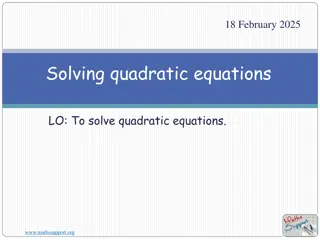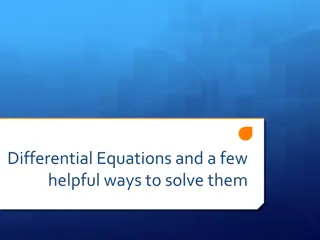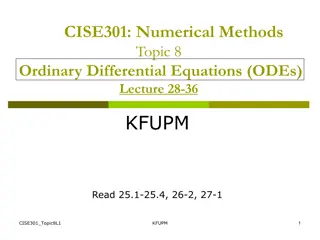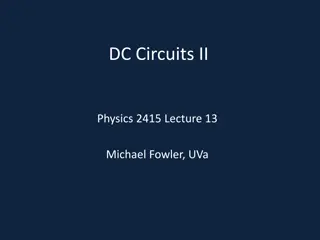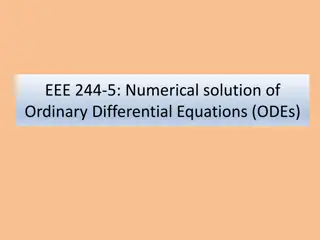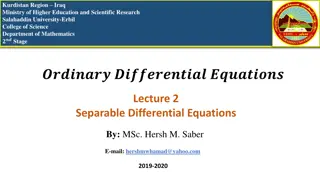Solving First-Order Differential Equations in Electrical Circuits
Spring 2022 class covers solving differential equations for RC and RL circuits. Learn about capacitors, inductors, transient solutions, and examples with initial conditions. Dive into circuit theory with practical applications.
Download Presentation

Please find below an Image/Link to download the presentation.
The content on the website is provided AS IS for your information and personal use only. It may not be sold, licensed, or shared on other websites without obtaining consent from the author.If you encounter any issues during the download, it is possible that the publisher has removed the file from their server.
You are allowed to download the files provided on this website for personal or commercial use, subject to the condition that they are used lawfully. All files are the property of their respective owners.
The content on the website is provided AS IS for your information and personal use only. It may not be sold, licensed, or shared on other websites without obtaining consent from the author.
E N D
Presentation Transcript
ECEN 214, Spring 2022 Electrical Circuit Theory Class 10: Solving First-Order Differential Equations for RC and RL Circuits Prof. Adam Birchfield Dept. of Electrical and Computer Engineering Texas A&M University abirchfield@tamu.edu
2 TPEC 2022: Texas Power and Energy Conference Feb 28 and Mar 1 in the MSC Research presentations in the power and energy area Free for Texas A&M students See more at tpec.engr.tamu.edu Office hours only until 2:30pm on Monday due to this
3 What We Learned Last Time Capacitors Fundamental equation: ? = ??? ??, where C is capacitance in Farads Add in parallel, combine in series the way resistors do in parallel In steady-state, they act like an open circuit Energy stored is ??2 Inductors Fundamental equation: ? = ??? ??, where L is inductance in Henries Combine in series and parallel the same way as resistors In steady-state, they act like a short circuit Energy stored is ??2 Transient circuit solutions We are solving for ? and ? as a function of time, ? ? and ?(?) Write the differential equations using KVL and KCL Today we will start to work on solving them
4 Solving First-Order Differential Equations in this Class Solving differential equations of the form ??? ??+ ?? ? = ? ? Along with initial conditions ? 0 = ?0 1. Find the homogenous solution of the form ?? ?? constant A. 2. Guess the particular solution based on the form of ?(?), using the table at right. 3. Combine the two solutions to find the general solution ? ? = ? ? + ??? 4. Apply initial condition?0 to find the unknown constant. Particular solution table for this class ??(?) ?(?) Constant - ?0 Linear - ?0+ ?1? Quadratic - ?0+ ?1? + ?2?2 Exponential - ??? ?1 ?0+ ?1? ?0+ ?1? + ?2?2 ?1??? ? by setting ? ? = 0, with an arbitrary Sine - sin(??) ?1cos ?? + ?2sin ?? Cosine - cos ?? ?1cos ?? + ?2sin ??
5 Example 1 Solve this differential equation for ? ? for ? 0, given initial condition ? 0 = 2 V 5?? ? ?? + 100,000 ? ? = 0
6 Example 1 Solve this differential equation for ? ? for ? 0, given initial condition ? 0 = 2 V 5?? ? ?? Homogenous solution: ? ? = ?? ?? Particular solution for? ? = ? + 100,000 ? ? = 0 ? = ?? 100000? 5= ?? 20000? ??? = ?1 Plug ?? into the original equation to get 100,000?1= 0, so ?1= 0 General solution is ? ? = ? ? + ??? =?? 20000?+ 0 Plug in the initial conditions y(0)=2, to get A=2. Answer is ? ? = 2? 20,000?. Can we confirm that this is correct? Check initial condition and derivative. ?? ? ?? ? 0 = 2? 20000 0= 2 V = 2 20,000 ? 20000?= 20,000 ? ?
7 Example 2 Solve this differential equation for ? ? for ? 0, in terms of ? and ?, given initial condition ? 0 = 0. ??? ? ?? = 5 ? ? ?
8 Example 3 ?? ??+ 3? ? = 2? + 5, ? 0 = 4
9 Solution to Example 3 ?? ??+ 3? ? = 2? + 5, ? 0 = 4. Step 1: Homogeneous solution: characteristic equation: ? + 3 = 0 ? = 3. ??? = ?? 3?. Step 2: Particular solution: assume ??? = ?? + ? plug into diff. eq.: ? + 3 ?? + ? = 2? + 5 rearrange: 3?? + ? + 3? = 2? + 5 equate coeff of t: 3? = 2 ? =2 equate constant term: ? + 3? = 5 ? =5 ? ??? =2 ??? ??= ? 3. = 13/9 3 3? +13 9.
10 Solution to Example 3 ?? ??+ 3? ? = 2? + 5, ? 0 = 4. Step 3: Form complete solution: y ? = ?? 3?+2 3? +13 9. Step 4: Apply initial condition: ? 0 = ? +13 9= 4 A = 49 9. Final answer: ? ? = 49 9? 3?+2 3? +13 9
11 Example 4 2?? ??+ 5? ? = 1, ? 0 = 3
12 Solution to Example 4 2?? ??+ 5? ? = 1, ? 0 = 3 Step 1 Find the Homogeneous solution 2?? ??+ 5? ? = 0 ? = ??? 2? + 5 = 0 ? = 5/2 ??? = ?? 5?/2 Step 2 Find the Particular solution Guess ? ? = ? 2(0) + 5? = 1 ? = 1/5. ??? = 1/5.
13 Solution to Example 4 Step 3 Combine homogeneous and particular solution to form complete solution. ? ? = ??? + ??? = ?? 5?/2+1/5. Step 4 Apply ICs to the complete solution to find the unknown constant. ? 0 = 3 ? +1 5= 3 ? = 14/5. 5? 5?/2 1 ? ? =14 5. Warning: Don t apply the initial condition until after you have formed the complete solution. This is a common mistake.
14 Example 5 Solve for both of the following voltages for ? > 0, given that they both begin at 150 V at t=0. The values of the capacitances are ?1= 1?? and ?2= 100??. (Note this is example 3 from last class.) ??1 ??=?1 ??2 ?? =?2 0.5 ?1 0.2 ?2
15 If You Need More Practice, Try Some of These
16 Assignments Quiz Monday Feb 28 on capacitors and inductors Quiz Wednesday Mar 2 on first-order RC and RL circuits Stay ahead of homework assignments and reading Homework 4 on Op-Amps is due Monday, Feb 28 Homework 5 on Inductors, Capacitors, first-order circuits is due Wednesday, March 2 Review in-class examples and notes Practice, practice, practice! Don t forget, you need to go to office hours once in either January or February and again in either March or April. Bring at least one technical question!
